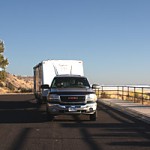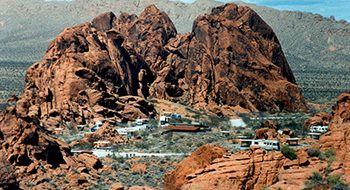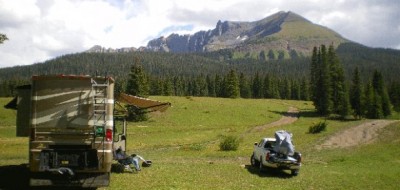By Bob Difley
 The van pictured is 100% electric and the first commercial vehicle to use batteries by Tesla Motors, manufacturer of the Tesla electric sports car (that will go from 0 to 60 mph in 4 seconds and has a 200+ mile range).
The van pictured is 100% electric and the first commercial vehicle to use batteries by Tesla Motors, manufacturer of the Tesla electric sports car (that will go from 0 to 60 mph in 4 seconds and has a 200+ mile range).
The interesting part of this story–at least to RVers–is that it was made by Freightliner Custom Chassis Corporation, that also manufactures motorhome chassis and is experimenting with a hybrid RV chassis, along with Morgan Olson LLC.
It has a gross vehicle weight rating of between 14,000 and 19,500 lbs and an electric driving range of 100-mile. Not quite enough for small motorhomes yet but with freightliner in the game you can expect that they will be looking in that direction, especially when fast-charging stations become commonplace.
Kudoos to Freightliner also for building it of lightweight, durable composites that are completely recyclable. They worked a lot on the aerodynamics, too, to get as much range as possible. But we will probably still go through years of get-there steps first, with hybrid RVs, then natural gas (CNG) powered motorhomes before the all-electric type evolves to higher mileage batteries and abundant charging stations.
There is more good news in the battery development field. A recent study finds that life-cycle analysis of electric vehicles–a type of study that aims to find the complete environmental impact of electric vehicles, taking into account manufacturing, usage, and disposal–turns out that batteries have an even lower impact than most of us thought.
The LCA study finds that the environmental burden caused by the lithium-ion battery is at most 15% of the total impact of the electric car (which includes making it, using and maintaining it, and disposing of it at the end of its useful life). The lithium itself represents just a small part of that; about 7.5% of the impact occurs when “refining and manufacturing the battery’s raw materials, copper and aluminium.” The lithium itself is only responsible for 2.3% of the total.
And as far as a lithium shortage? Not Anytime Soon. Bolivia alone has enough lithium for billions of electric cars and they only have about 1/3 of known world supplies (if there’s ever a big shortage, higher prices would probably lead to new discoveries), and lithium isn’t destroyed when used in a battery, so it can be recycled and reused.
The total impact of EV batteries can be further reduced if at the end of their “vehicle” life they are used for other forms of energy storage, since they can still hold up to 80% of their charge–even after having been used for years in a vehicle. So before recycling them, they could be used to store power on the grid (such as intermittent power from wind farms).
You can read the full story here.
For general RVing and boondocking tips, visit my Healthy RV Lifestyle website and also check out my ebooks,BOONDOCKING: Finding the Perfect Campsite on America’s Public Lands, Snowbird Guide to Boondocking in the Southwestern Deserts, and 111 Ways to Get the Biggest Bang our of your RV Lifestyle Buck.



Pingback: ניסור בטון
Bob Senesi
Interesting van concept. Glad to see it is “all electric” unlike other vehicles which are billed as “electric” vehicles but are actually hybrids.
Having spent a career in electronics and software, I am curious how a vehicle such as this could be driven a reasonable distance (sans recharge) and still be able to afford the operator the comfort of all weather heating and air conditioning. As far as I can determine there needs to be a quantum leap in electric cell technology before any of this can be deemed practical and attract the interest of prospective fleet owners, drivers as well as RVers.
G Shea
CNG has been used on buses for over a decade. The tanks are not that big since it is compressed. When will it make it to RVs? It can be bought in most big cities, but there would have to be better availabiloty for it to become a worthy RV fuel. Cars and small trucks can get close to 80 MPG on it, and the agency I drive for gets it for less than a dollar per gallon. Our city taxis use it, when will it go nation wide to help the enviroment, and our dependancy on oil? I bet it won’t be soon, to many road blocks to a worthy “bridge” fuel.
G Shea
Gary Gee
I tried signing up for your mini-mag and your goofy web site says the info you have for my email address doesn’t match what you have on file. The site will not give me an opportunity to change the info that is not correct.
Geoffrey Pruett
The “Better Place” idea looks good on the surface but seems an approach to the disposible car. Think of a fender bender which warps the sheet metal. This must be a government project, can you feature auto makers in America producing a standardized plug in area? The out of vehicle battery service is a large plus, have been repairing multi-cell rechargables for years and single cell failure is a constant and ongoing item. This only becomes a problem if multiple recharges are attempted with a shorted cell in the system, a problem readily monitored during recharging with a properly designed system. The Lithium cell chargers used with my models already use this type of monitoring and will just shut down on a failed cell instead of overheating the entire battery. The other plus is that Lithium is probably not the final answer and upgrading out of the car is at least cost effective.
Bob Difley
Jim asks, “would it not be a good idea to create a system were we could rent the battery pack then there could be stations along the road that would be totally automated
You drive into a booth a lift would remove the battery pack from your vehicle then insert a fully charged pack back into the rig.”
In fact, one company is already doing that with operations set up in Israel and Denmark and with plans to go global. The company is called Better Place and you can see how the battery switching operation works at this link:
http://www.betterplace.com/the-solution-switch-stations
Bob Worrall
Good people,
Below is a press release dated July 14th 2010 which I downloaded from http://www.smithelectricvehicles.com/
Go to the link which says “Rest of the World” on the home page, and then to “News” Smith Electric Vehicles is a UK company which has been around since 1920.
As you can see Freightliner are not the only ones getting US government money for Electric vehicles. In the UK Smith base their vehicles on Ford Products, and probably do not have the same low weight as the Freightliner body and chassis shown. .
Interestingly Mercedes own Freightliner and also part of Tesla.
I think that the electric RV is some way away yet. The current focus is on delivery vehicles in crowded inner cities, with lots of stops, starts, and traffic jams. The vehicle shown in the photograph looks like a delivery van to me,.
I make no comment about a factory visit by Mr Obama being a good or a bad thing.
My personal benchmark for the US government getting serious about electric vehicles is when I see the first all electric US mail delivery truck outside my front door. In London, two courier services, TNT and DHL, as well as the Royal Mail, have electric vehicles on trial.
My prediction for RVs in the medium term is diesel. I personally drive a Sprinter, which is excellent. CNG will be good if it is available nation wide, which it does not seem to be yet. Also a CNG fuel tank will be bigger and heavier than for a simple modern diesel system.
Smith electric Vehicles press release:-
President Obama Praises Smith Electric Vehicles
=======================================
The President of the United States praised workers at global electric truck company Smith Electric Vehicles for helping to rebuild America’s economy.
Barack Obama made a special trip to visit the headquarters of Smith Electric Vehicles US Corporation (Smith US) in Kansas City, Missouri, where he met with the plant’s workers and their families.
The President said: “I just had a chance to get a tour and saw some of the battery-powered trucks that you’re manufacturing. I had a chance to talk to some of the folks who build them.
“But the reason I’m here today is because, at this plant, you’re doing more than just building new vehicles. You are helping to fight our way through a vicious recession and you are building the economy of America’s future.”
Barack Obama also announced that the plant had recently employed its 50th worker as it continues to increase production of its Smith Newton all-electric truck.
He added: “This is how we take charge of our destiny. This is how we create jobs and lasting growth. This is how we ensure that America not only recovers, but prospers – that this nation leads in the industries of the future.
“Yes, this has been a difficult period for America: two years of brutal recession; a decade of economic insecurity. And there will be more hard days. That’s the truth. But what you are proving here at Smith Electric is the promise of a brighter future.”
Designed for urban operations, the Newton has a top speed of 50mph, a range of up to 100 miles on a full battery charge and payload capabilities of up to 16,000lbs (7,500kg).
Smith US, which only commenced production in October 2009, has already delivered vehicles to blue chip customers including AT&T, Frito-Lay, Coca-Cola and Staples; plus utilities Pacific Gas & Electric and Kansas City Power & Light.
Smith US is an associate company of Smith Electric Vehicles UK (Smith UK), which was founded in 1920 and is longest established electric vehicle manufacturer in the world. Based in Tyne & Wear, the company produces the world’s largest range of electric commercial vehicles (vans and trucks), in the Smith Edison van and minibus (electric Ford Transit) and the Smith Newton truck. Hundreds of these electric vehicles are now in service in the UK, Ireland, Netherlands, France, Hong Kong and Southern China.
Smith UK is also working on a pure electric version of the iconic London black taxi.
Earlier this year, Smith US announced a conditional offer to buy the Smith UK operation, creating a single global company focused on commercial electric vehicles.
Don MacConnel
The Tesla battery approach is interesting in that it uses some 6700 individual cells of a standard design and form factor. It’s an expensive assembly but of course so is the car. Their objective was to get the car on the road as quickly as possible.
I like Jim’s idea about replacing the stack and ultimately expect that some sort of liquid replacement scheme would be available. That is, drain out the charge depleted fluid and pump in a fresh “charge.”
No matter what, Bob Difley makes a good case for a migration path that could use CNG or my favorite, learned from Disney, LNG.
Jim
would it not be a good idea to create a system were we could rent the battery pack then there could be stations along the road that would be totally automated
You drive into a booth a lift would remove the battery pack from your vehicle then insert a fully charged pack back into the rig.
there could even be an alert system that could let you know were the nearest battery swap station is and that you will make it there to do your swap. the swap station would know approximately when you were to arrive and have your battery pack ready. the swap would take no longer then what it would take to put gas in rig
then the problem of recycling batteries would not be an issue the swap station would be able to do diagnostic on the battery pack and replace when necessary
i believe that the auto manufactures should start considering this idea in their design of electric vehicle